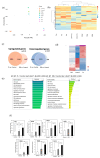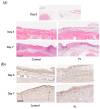Molecular Insights into the Superiority of Platelet Lysate over FBS for hASC Expansion and Wound Healing
- PMID: 40801587
- PMCID: PMC12346565
- DOI: 10.3390/cells14151154
Molecular Insights into the Superiority of Platelet Lysate over FBS for hASC Expansion and Wound Healing
Abstract
Human adipose-derived stem cells (hASCs) are widely used in regenerative medicine due to their accessibility and high proliferative capacity. Platelet lysate (PL) has recently emerged as a promising alternative to fetal bovine serum (FBS), offering superior cell expansion potential; however, the molecular basis for its efficacy remains insufficiently elucidated. In this study, we performed RNA sequencing to compare hASCs cultured with PL or FBS, revealing a significant upregulation of genes related to stress response and cell proliferation under PL conditions. These findings were validated by RT-qPCR and supported by functional assays demonstrating enhanced cellular resilience to oxidative and genotoxic stress, reduced doxorubicin-induced senescence, and improved antiapoptotic properties. In a murine wound model, PL-treated wounds showed accelerated healing, characterized by thicker dermis-like tissue formation and increased angiogenesis. Immunohistochemical analysis further revealed elevated expression of chk1, a DNA damage response kinase encoded by CHEK1, which plays a central role in maintaining genomic integrity during stress-induced repair. Collectively, these results highlight PL not only as a viable substitute for FBS in hASC expansion but also as a bioactive supplement that enhances regenerative efficacy by promoting proliferation, stress resistance, and antiaging functions.
Keywords: RNA sequencing; antiaging effects; cell proliferation; human adipose-derived stem cells; platelet lysate; stress resistance.
Conflict of interest statement
The authors declare no conflicts of interest. The funders had no role in the study’s design; in the collection, analyses, or interpretation of data; in the writing of the manuscript; or in the decision to publish the results.
Figures







Similar articles
-
Human platelet lysate-cultured adipose-derived stem cell sheets promote angiogenesis and accelerate wound healing via CCL5 modulation.Stem Cell Res Ther. 2024 Jun 9;15(1):163. doi: 10.1186/s13287-024-03762-9. Stem Cell Res Ther. 2024. PMID: 38853252 Free PMC article.
-
Prescription of Controlled Substances: Benefits and Risks.2025 Jul 6. In: StatPearls [Internet]. Treasure Island (FL): StatPearls Publishing; 2025 Jan–. 2025 Jul 6. In: StatPearls [Internet]. Treasure Island (FL): StatPearls Publishing; 2025 Jan–. PMID: 30726003 Free Books & Documents.
-
Unveiling the molecular mechanisms of human platelet lysate in enhancing endometrial receptivity.Hum Reprod. 2025 Jul 15:deaf118. doi: 10.1093/humrep/deaf118. Online ahead of print. Hum Reprod. 2025. PMID: 40663777
-
Efficacy of Humanized Mesenchymal Stem Cell Cultures for Bone Tissue Engineering: A Systematic Review with a Focus on Platelet Derivatives.Tissue Eng Part B Rev. 2017 Dec;23(6):552-569. doi: 10.1089/ten.TEB.2017.0093. Epub 2017 Jul 28. Tissue Eng Part B Rev. 2017. PMID: 28610481
-
Management of urinary stones by experts in stone disease (ESD 2025).Arch Ital Urol Androl. 2025 Jun 30;97(2):14085. doi: 10.4081/aiua.2025.14085. Epub 2025 Jun 30. Arch Ital Urol Androl. 2025. PMID: 40583613 Review.
References
MeSH terms
Grants and funding
LinkOut - more resources
Full Text Sources
Medical
Miscellaneous

